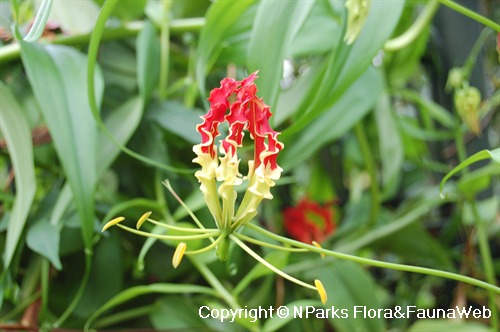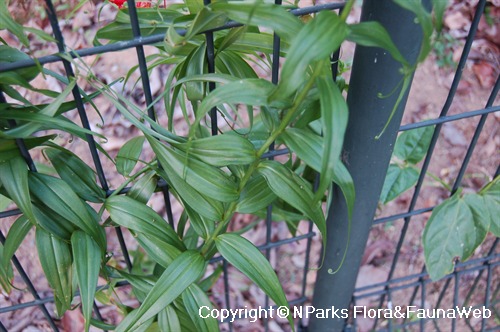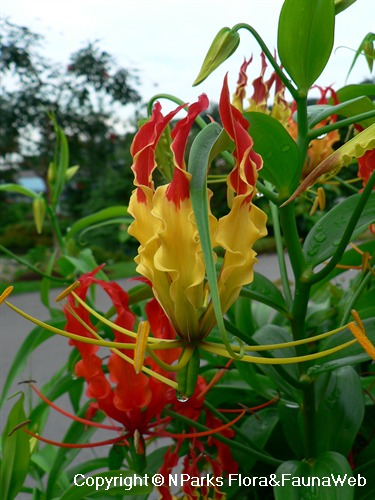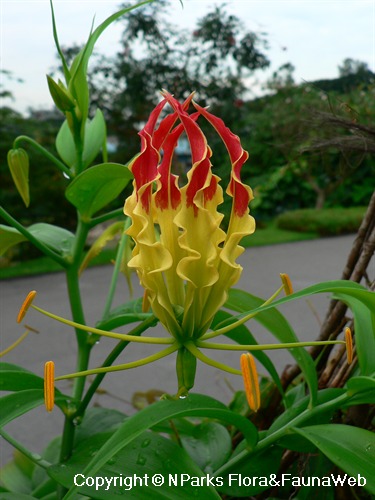
Back
Gloriosa superba L.
| Family Name: | Colchicaceae |
| Synonyms: | Androcymbium Lily, Gloriosa homblei, Clinostylis speciosa, Gloriosa virescens, Gloriosa speciosa, Gloriosa abyssinica |
| Common Name: | Climbing Lily, Tiger's Claws, Tiger Claw, Flame Lily, Glory Lily, Gloriosa Lily, 嘉兰 |
Name
Classifications and Characteristics
| Plant Division | Angiosperms (Flowering Seed Plants) (Monocotyledon) |
|---|---|
| Plant Growth Form | Climber, Herbaceous Plant |
| Lifespan (in Singapore) | Perennial |
| Mode of Nutrition | Autotrophic |
| Plant Shape | Irregular, Open |
| Maximum Height | 2 m to 3 m |
Biogeography
| Native Distribution | Tropical Africa, Indian sub-continent, China, Indochina, Indonesia |
|---|---|
| Native Habitat | Terrestrial (Monsoon Forest, Grassland / Savannah/ Scrubland) |
| Preferred Climate Zone | Tropical, Sub-Tropical / Monsoonal |
Description and Ethnobotany
| Growth Form | Scandent, weaked-stemmed twining vine, up to 3m. Understorey plant in dry forests and thickets in native habitat. In areas with distinct dry seasons, plant dies down after flowering and goes dormant. |
|---|---|
| Roots | Rhizomatous rootstock, horizontal and usually forked. |
| Foliage | Leaves resemble those of Nepenthes (Pitcher Plant), with slender grasping tendrils at tips, allowing plant to coil around supports. |
| Flowers | Flowers showy, with reflexed red-yellow tepals and prominent basal styles. |
| Fruit | Fruits are explosive capsules with many hard seeds. |
| Others - Plant Morphology | It can be grown for exotic-looking flowers and a source of flamboyant colour in semi-shady areas. Despite its beauty, all parts of plant (especially roots) contain colchicine and other related alkaloids, which is extremely toxic and possibly fatal if ingested. |
| Habitat | Dry forests |
| Etymology | Genus epithet 'gloriosa' means 'glorious' or 'handsome', and species epithet 'superba' means 'superb' – both references to the attractive flowers. |
| Ethnobotanical Uses | Others: Grown commercially for harvest of alkaloids. Used to treat intestinal worms and infertility. Sap from leaf tips used for pimples and skin eruptions in Africa. National flower of Zimbabwe and state flower of Indian state of Tamil Nadu. |
Landscaping Features
| Desirable Plant Features | Ornamental Flowers |
|---|---|
| Landscape Uses | Container Planting, Vertical Greenery / Green Wall |
| Thematic Landscaping | Naturalistic Garden |
| Usage Hazard - Cons | Irritant - Sap, Toxic Upon Ingestion |
| Usage Hazard - Cons Remarks | Entire plant contains a toxin (colchicine), with highest concentration in roots. Leaf and stem sap can cause skin irritation. |
Fauna, Pollination and Dispersal
| Seed or Spore Dispersal | Abiotic (Explosive Dehiscence) |
|---|
Plant Care and Propagation
| Light Preference | Semi-Shade, Full Sun |
|---|---|
| Water Preference | Moderate Water |
| Plant Growth Rate | Moderate |
| Rootzone Tolerance | Fertile Loamy Soils, Well-Drained Soils |
| Maintenance Requirements | Moderate |
| Propagation Method | Seed, Storage Organ, Sucker, Division |
| Propagule Establishment Remarks | Seed germination may take up to 9 months. |
Foliar
| Foliage Retention | Evergreen |
|---|---|
| Mature Foliage Colour(s) | Green |
| Mature Foliage Texture(s) | Smooth, Glossy / Shiny |
| Foliar Modification | Foliar Tendril |
| Foliar Type | Simple / Unifoliate |
| Foliar Arrangement Along Stem | Opposite |
| Foliar Shape(s) | Non-Palm Foliage (Lanceolate) |
| Foliar Venation | Parallel |
| Foliar Margin | Entire - Wavy / Undulate |
| Foliar Apex - Tip | Caudate |
| Typical Foliar Area | Notophyll ( 20.25cm2 - 45 cm2 ) |
Non - Foliar and Storage
| Stem Type & Modification | Herbaceous |
|---|---|
| Root Type | Underground (Fibrous Root) |
| Specialised Storage Organ(s) | Underground (Rhizome) |
Floral (Angiosperm)
| Flower & Plant Sexuality | Bisexual Flowers |
| Flower Colour(s) | Red, Yellow / Golden |
|---|---|
| Flowering Period | Free-Flowering |
| Flowering Habit | Polycarpic |
| Inflorescence Size Remarks | Flower tepals emerge yellow, and become more red-tipped as they extend. |
Fruit, Seed and Spore
| Fruit Classification | Simple Fruit |
|---|---|
| Fruit Type | Dehiscent Dry Fruit , Capsule |
Image Repository
Others
| Master ID | 110 |
|---|---|
| Species ID | 1406 |
| Flora Disclaimer | The information in this website has been compiled from reliable sources, such as reference works on medicinal plants. It is not a substitute for medical advice or treatment and NParks does not purport to provide any medical advice. Readers should always consult his/her physician before using or consuming a plant for medicinal purposes. |






